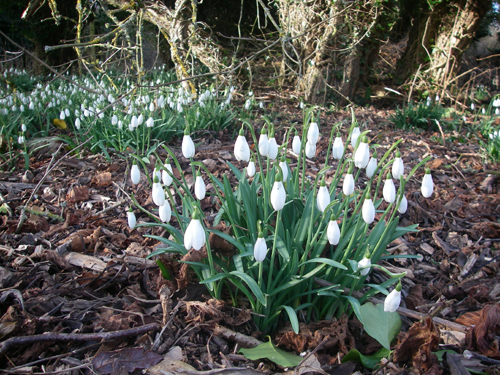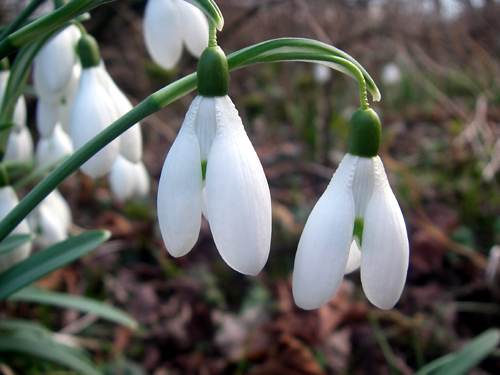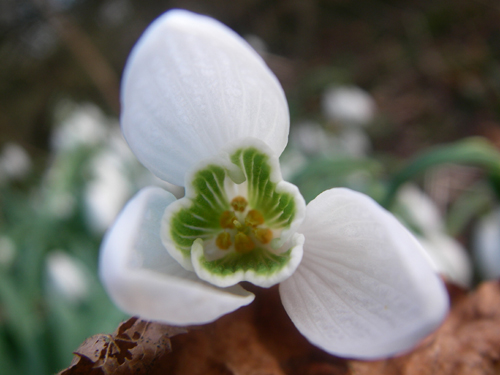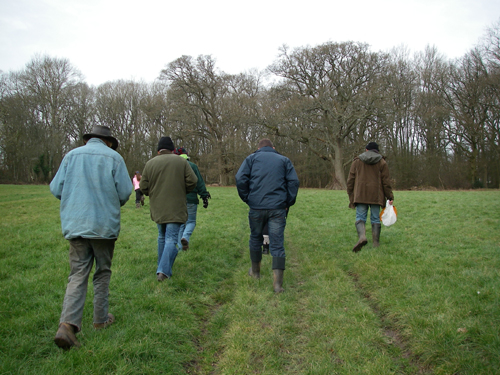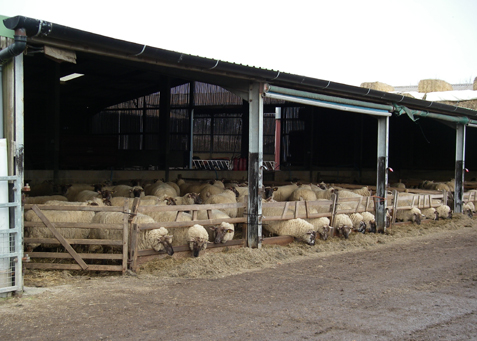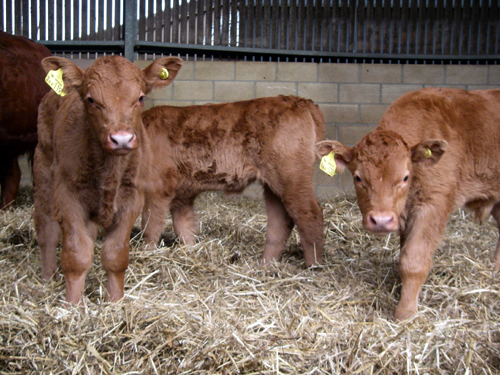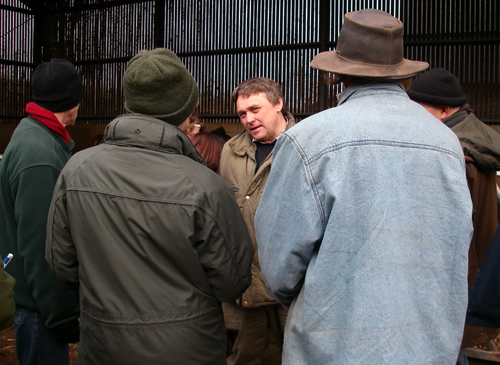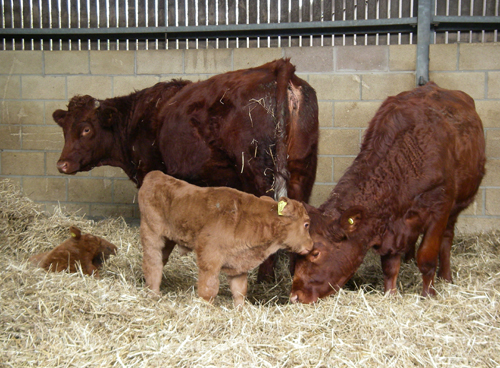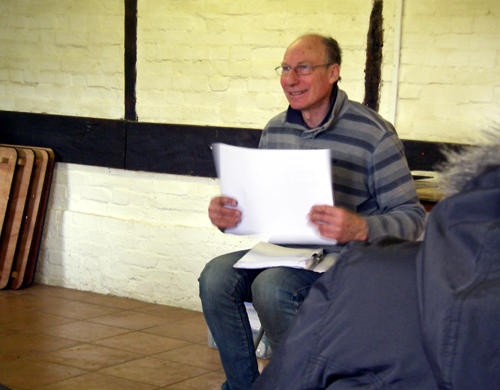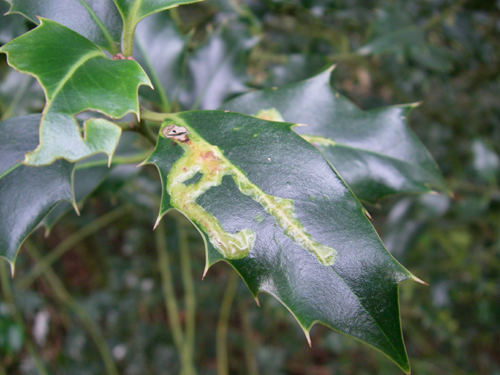From sub-zero freezing conditions only a week ago to increasingly mild days where hedgerows are alive with the racket of bird turf wars… Yep, spring is approaching. My car is better (hooray!), wildlife is stirring about (a friend told me yesterday that he’d seen his first Adder of the year) and winter is beating a retreat.
Snowdrops Galanthus nivalis are a flower traditionally associated with February, especially the seasonal Celtic festival of Imbolc (or Candlemas, in the Christian faith) that is celebrated around 1st February. Taken from the Irish i mbolg meaning “in the belly” or oimelc meaning “ewes’ milk”, both refer to the fact that this is the season for lambing. I’m particularly fond of snowdrops and other early spring flowers: there something almost miraculous about a plant which shoves its way through still-frozen ground to produce a flower that only the hardiest of early-stirring insects are likely to discover. As a result, most snowdrops in the UK reproduce by division of bulbs rather than by seed… Yet where they occur in woodlands and hedgerows they can often multiply to spectacular proportions, creating a starry carpet of white flowers against blue-green foliage that is second only to the display that bluebells produce later in spring.
No-one seems entirely sure whether snowdrops are a native British wild flower or not: they are native to continental Europe, so while some botanists seem to believe that they were introduced to this country in the sixteenth century, others suggest that perhaps there were isolated wild populations already here that were augmented by human plantings. The whole native/non-native wildlife species debate always stirs up strong opinions, but until genetics definitively proves the snowdrop’s origins one way or the other I guess we’ll just have to be content with enjoying looking at them. One local site that is well-known for its snowdrop vistas is Welford Park: there is an entry charge for viewing the gardens but some of the funds raised go towards local charities. I’m also reliably informed (by some friends who went there last weekend) that the tea room there has deeply satisfying cake.
Being the kind of naturalist who loves grubbing around in the leaf litter, I often get down on hands and knees to examine small stuff more closely, so I can recommend the view of snowdrops from this angle. Try turning one of the delicate flowers carefully upward to peer inside: around the yellow anthers, a graceful tracery of spring-green veining marks the inner tepals (tepals being botany-speak for a type of petal). It’s every bit as attractive as a lily or an orchid, albeit on a smaller scale.
Returning to the lambing theme, mid-February saw me up at Rushall Organic Farm with the rest of the farm’s education team, for a training day prior to the very busy school visit season that starts as soon as the lambs begin arriving. Rushall Farm is a popular environmental education site for schools from all over the local area and also from London, running sessions for all abilities and ages from pre-schools to A-level students and above. I started working there in 2011 and have enjoyed every minute: although I’ve been a field teacher for about twenty years now, I had little experience of farm education (despite my grandpa having been a farm manager), so it’s been both challenging and fascinating for me to lead sessions at the site. Because of the students’ age range and variety of habitats, in any one week you can be teaching about soil science, crop rotation, organic principles, freshwater biology, economic diversification, woodland management, minibeasts, or simply experiencing the fun of holding lambs and feeding livestock.
Rushall is a mixed arable and livestock farm and sheep are a big part of its operation (providing about a third of its income). There are nearly 800 pregnant ewes currently gathered in the lambing sheds, scoffing their way through high-energy and protein feeds such as beans, oats and silage. The first lambs are due any day now, which is when many schools want to visit: there is a big “Awwww” factor in cuddling lambs, although we try our best also to instil some of the more important messages about farming. Food security and sustainability are (finally) rising up the political agenda in the UK as well as world-wide, and with the increasing cost of fossil fuels which underpin ‘conventional’ farming methods, it’s likely that organic farming will be playing a bigger role in supplying some of our food needs. At present only 4% of British farmland is organically managed (as compared with 10% in Denmark, Austria or Italy)… So it looks like we could do better.
The argument oft trotted out against organic food is the cost: but interestingly, this is becoming less of an issue as food prices overall have risen steeply in past months. The central principles of organic farming are to work with natural systems, sustain soil fertility whilst minimising environmental impact, ensure ethical animal treatment and protect and enhance wildlife and natural habitats. Personally, I’m prepared to pay a little bit extra for most of my food to ensure this. Most people eat more than they need to anyway (and then spend a fortune on expensive gym membership or diets), so maybe supporting British organic farmers with at least some of your food shopping budget might be a better way forward.
Of course, the livestock part of the farm is not about cuddling lambs but about meat production. (Vegans, look away now.) As well as sheep, Rushall has a herd of about 100 suckler cows and calves. In a suckler herd each cow will ideally calve once a year (in January/February at Rushall) and suckle her calf for eight or nine months; the calf then goes off to be finished (i.e. continue growing for some months before slaughter for meat), whilst the cow has a few weeks rest before becoming pregnant again. It’s a fairly inefficient system with a high carbon footprint, which is why farmers are always looking for ways to improve the process. One of the solutions has been the development of a new breed of cattle known as the Stabiliser: a cross between four different breeds (Red Angus, Hereford, Gelbvieh and Simmental) to produce a cow that combines traits which are desirable for livestock.
On our training day we were joined by Neil Rowe, farm manager for Manor Farm in Oxfordshire (owned by William Cumber, Rushall Farm’s owner). Neil give us a fascinating presentation about the Stabiliser breed, which Rushall’s cattle herd is now largely made up of. Stabiliser cattle can calve younger than other breeds (at two years rather than at three), tend to be healthier (because of hybrid vigour), cope well with all climates, have small calves (and hence easier calvings), are docile and convert food into beef efficiently. Because of these beneficial traits, they are worth twice as much as other cattle breeds. The only problem (as Neil saw it) is the breed’s name, which at present has virtually zero recognition with UK consumers when the meat is marketed, despite it tasting (apparently) as good as prime Aberdeen Angus.
I like cows and I’m (mostly) vegetarian so the whole beef industry thing is problematic for me, but in a mixed organic farming system livestock contribute significantly to soil fertility via their manure and also form part of a wider countryside ecosystem and landscape which I am deeply attached to. On an economic note, world demand for beef is high and production is falling: in the US, 42% of grain in 2011 went towards biofuels production rather than to animal feed. One of Neil’s current projects is to develop an international scheme for Fair Trade certification of animal feed (such as grain), which seems to me a worthy endeavour that I wish him lots of luck with.
Neil also had some interesting views on the current bovine TB issue. Badger culling is being proposed to start in autumn 2012 in areas of Somerset and Gloucestershire, despite current evidence indicating that this will not ameliorate the bovine TB problem and may even exacerbate it. More attention should be given to issues such as poor cattle husbandry, feeding animals with maize (which impacts their immune system) and most importantly illegal cattle movements. Neil made the startling point that there are roughly seven million cattle movements every year in the UK… and only four inspectors.
On a happier and hopefully less controversial note, John Bishop (Rushall’s farm manager) was able to share with us the happy news that the farm has just been accepted into the Higher Level Scheme (HLS) where the government gives money to farmers specifically for undertaking measures that support wildlife. Rushall is already also in the Organic Entry Level Scheme (OELS), so the two combined payments will hopefully form a significant part of the farm’s income over the next few years. This is a good example of positive government involvement in the countryside… It would be nice if there was more of it. Some of the wildlife improvements will include creating species-rich semi-natural grassland, planting wild flower margins, carrying out management to support nesting and breeding birds and looking after waterside meadows on the farm. So hopefully, we will be seeing even more wildlife around Rushall than we already do.
Although many of the schools who visit Rushall do so to see the livestock, I have to own a persistent attachment to the apparently less-glamorous world of invertebrates and plants. Apart from pond dipping and minibeast safaris it’s not always easy to sell children (or adults) on the attractions of bugs, whilst plants seem even less interesting. But I persevere. So to conclude this blog entry, I leave you with the intriguing world of leaf miner insects. Even in the depths of winter you can find evidence of this particular group of small animals who make their homes in leaves and stems, munching their way through the tissues whilst remaining largely hidden from possible predators. It’s a bit like living in your bed for the winter with an endless supply of food, something I’m sure which has appealed to most of us at some point during the long dark days of January. During our training day we went on an invertebrate sampling walk and found the distinctive mines of Phytomyza illicis in the leaves of a Holly Ilex aquifolium. So next time you’re on a winter ramble and want to impress someone, you can casually point to a Holly leaf and murmur, “Ah, Phytomyza…” I plan to try it, anyway.

